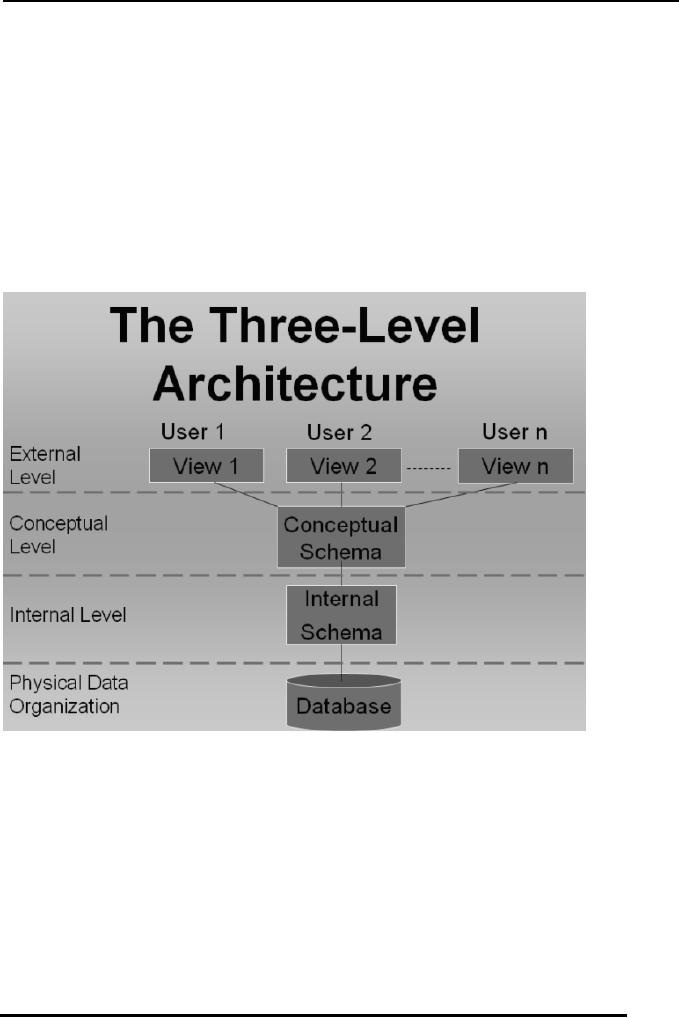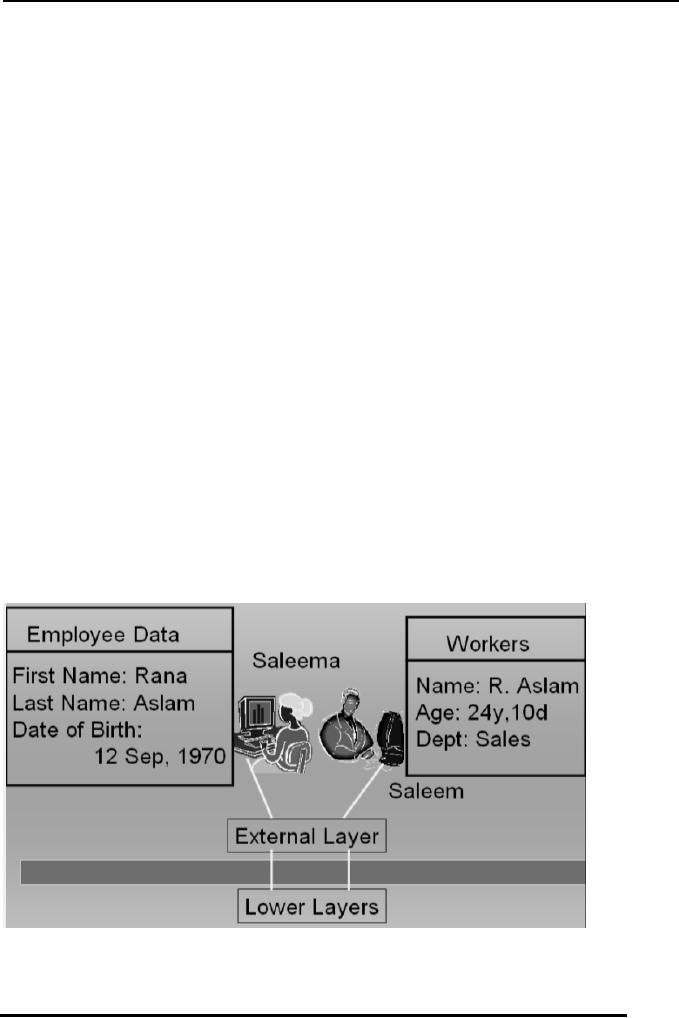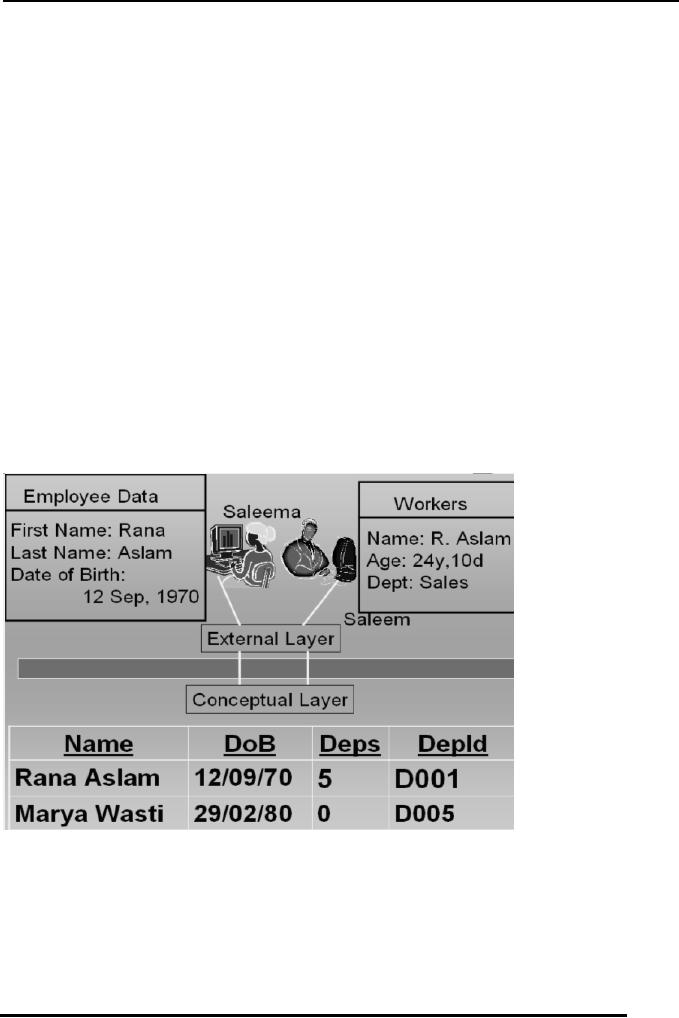 |

Database
Management System
(CS403)
VU
Lecture No.
03
Reading
Material
"Database
Systems Principles, Design
and Implementation"
Section:
4.1.1,
written by
Catherine Ricardo, Maxwell
Macmillan.
4.1.2
Overview of
Lecture
o Database
Architecture
o External
View of the database
o Conceptual
view of the database
Database
Architecture:
Standardization of
database systems is a very
beneficent in terms of
future
growth,
because once a system is
defined to follow a specific
standard, or is built
on a specific
standard, it provides us the
ease of use in a number of
aspects.
First if any
organization is going to create a new
system of the same usage
shall
create
the system according to the
standards and it will be
easier to develop,
because
the standards which are
already define will be used
for developing the
system.
Secondly if any
organization wants to create
and application software
that will
provide
additional support to the
system, it will be an easier
task for them to
develop
such system and integrate
them into existing database
applications.
Users
which will be using the
system will be comfortable
with the system
because a
system built on predefined
standards is easy to understand
and use,
rather
than understanding learning
and using an altogether new
system which is
designed
and built without following
any standards.
31

Database
Management System
(CS403)
VU
Expansion to
systems which are not
built on standards is very
hard and needs
lots of
efforts.
Technical
staff working on a system
built on standard has no
problem to learn the
use
and architecture of the
system and whenever there is
a need in change of
staff new
staff members can be hired
and put to work without any
prior training
for
the use of system.
Database
standard proposed by ANSI
SPARK in 1975 is being used
worldwide
and is
the only most popular
agreed upon standard for
database systems.
The Three
Level Schema architecture
provides us a number of benefits.
For
accessing
data at different levels we
have a number of users
because not all
users
have to access data in
database at all the database
levels. The 3 levels
architecture
allows us to separate the
physical representation of data
from the
users'
views of data.
In the
database, same data is
stored in a specific feasible
format and is
available
to different
users in different formats as
desired by different users.
For example,
consider we
have stored the DOB
(Date of Birth) in the
database in a particular
format,
like in the form of
dd-mm-yyyy (for example,
28-03-1987). However,
the
users
from different departments may
require to view the date of
birth in different
forms;
the examination department may
ask it to be displayed as
month-day-yyyy
(like
march-28-1987) the Registrar's
office may ask to display
date of birth as
mm/dd/yyyy,
still the Library may need
the in the form of dd/mm/yy.
The Three
Level
Schema allows us to access
the data in different
formats at the
external
level,
which is stored in a specific
format at the internal
level.
The Three
levels architecture is useful
for hiding the details of
internal systems; it
in-fact
hides the details of
underlying system views from
the users at other
levels
and
restricts the access of data
and the system from any
unauthorized
intervention. It
is the mechanism which
allows us to store the data
in the system
in such a way
that it can be provided to
all users in their desired
formats and with
unveiling
other details and
information stored in the
database. Moreover if
there
is a change to be
done to the data stored in
the database subject to
the
32

Database
Management System
(CS403)
VU
requirements of a
specific user it needs not
be changed for that user
specifically,
we can
create a change to the
specific external view of
that user and the
internal
details
remain unchanged. Also if we
want to change the
underlying storage
mechanism of
the data stored on the
disk we can do it without
affecting the
internal
and conceptual view at the
lowest level in the three
levels architecture is
the
internal view or internal
level which is shown below
in the diagram and is
illustrated in
the coming lines.
Fig. 1:
Three level architecture of
database
The
Architecture:
The schemas as it
has been defined already; is
the repository used for
storing
definitions of
the structures used in
database, it can be anything
from any entity
to the
whole organization. For this
purpose the architecture
defines different
schemas
stored at different levels
for isolating the details
one level from the
other.
33

Database
Management System
(CS403)
VU
Different
levels existing at different
levels of the database
architecture are
expressed
below with emphasis on the
details of all the levels
individually.
Core of
the database architecture is
the internal level of schema
which is
discussed a
bit before getting into
the details of each level
individually. The
internal
level implements all the
inner details and defines
the intentions of the
database.
Internal schema or view
defines the structures of
the data and
other
data
related activities in the
database. For example it
defines that for a
student
what
data will be stored in terms
of attributes of the student
and it also defines
how different
values for these attributes
will be stored, also it
tells that who is
allowed to
make changes to the database
and what changes he can
make, etc.
These
details give us the internal
schema and are called
the intention of the
database.
Intention
for a
database is almost permanent,
because while
designing
the database it is ensured
that no information is left
behind which is
important
enough to be stored in the
database and what
information is important
to be stored in
the database from the
future point of view.
Once
the intention of the
database has been defined
then it is undesirable to
change
the intention for any
reason. Because any small
change in the
intention
of the
database may need a lot of
changes to be made to the
data stored in the
database.
Extension
of
the database is performed on
the bases of a
complete
intention,
i-e once a database has
been defined it is populated
with the data of
the
organization for which the
database is created. This
population of the
database is
also called as the extension
of the database. Extension is
always
done
according to the rules
defined in the internal
schema design or the
intention
of the
database.
Effects of changes
made to different levels of the database
architecture:
We can
make changes to the
different levels of the
database but these
changes
need
very serious consideration
before they are made,
Changes at different
levels of
database architecture need
different levels of users
attention for
example a
change to the data made
for the extension of data
will effect only a
single
record whereas when we make a
change to the internal level
of the
34

Database
Management System
(CS403)
VU
database
the change effects all
the stored records,
similarly an invalid change
in
the
extension of the database is
not that fatal as a change
in the intention of
the
database
because a change in the
extension of the database is
not very hard to
undo;
incase of a mishap whereas a
change of the same magnitude
to the
intention of
the database might
cause a
large number of database
errors
(inconsistencies
and data loss).
External View
(Level, Schema or Model):
This
level is explicitly an end
user level and presents
data as desired by
the
users of
the database. As it is known
that the database users
are classified on
two
grounds
o Section of
the organization
o Nature of
Job of the users
The external
level of the database caters
to the needs of all the
database users
starting
from a user who can view
the data only which is of
his concern up-to
the
users who
can see all the
data in the database and
make all type of actions
on
that
data.
External
level of the database might
contain a large number of
user views, each
user
view providing the desired
features and fulfilling
requirements for the user
or
user
group for which it is
intended. The restriction or liberty a
user or user groups
get in
his rights is the external
view of that user groups
and is decided very
carefully.
External
views are also helpful when
we want to display the data
which is not
place in
the database or not stored
at all. Example of the first
case can be a
customer
Phone number stored in the
database. But when contacting
the person
it might
appear that the area
code for that specific
user is not stored in
the
database, in
that case we can simply
pick up the area or city id
of the customer
and
find the area code
for that city from
the corresponding Area Codes
table.
Another
situation may arise when we want to
get a student enrolled in
an
institution
and want to make sure
that the student qualifies
for the minimum
required
age limit, we will look
the database, for the
students age but if we
have
35

Database
Management System
(CS403)
VU
stored
only the date of birth of
the student then the
age of the student needs
to
be calculated at
that very instance; this
can be done very easily in
the specific
user
view and age of the
student can be calculated,
even the user-view itself
can
tell
use whether the student
qualifies for the admission
or not.
As the
user view is the only entity
or the interface through
which a user will
operate
the database or use it so it
must be designed in such a way
that it is
easy to
use and easy to manage
and self descriptive, also
it is easy to navigate
through.
Also it should not allow
the user to get or retrieve
data which is not
allowed to
the user, so the user
view should both be a
facilitator and also
a
barrier
for proper utilization of
the database system.
As the
system grows it is possible
that a user view may change
in structure,
design
and the access it provides
to the users. SO External
views are designed
and
create in way that they can
be modified at a later stage
without making any
changes in
the logical or internal
views.
In the
diagram below we can see
two different users working
as end users
having
their own external view; we
can see that the
same data record is
displayed in
two entirely different
ways.
Fig. 2:
Mapping between External
layer and lower
layers
36

Database
Management System
(CS403)
VU
Conceptual or
Logical View:
This is
the level of database
architecture which contains
the definition of all
the
data to be
stored in the database and
also contains rules and
information about
that
structure and type of that
data.
The conceptual
view is the complete
description of the data
stored in the
database. It
stores the complete data of
the organization that is why it is
also
known as
the community view of the
database. The conceptual view
shows all
the
entities existing in the
organization, attribute or
characteristics associated
with
those entities and the
relationships which exist
among the entities of
the
organization.
We can
take the example of the
customers of a company. Now the
conceptual
schema
will have all the
details of the products of
the company, retailing
stores of
the
company, products present in
the stock, products which
are ready to be
delivered,
salespersons of the company,
manager of the company and
literally
every
other thing which is
associated with the business
of the company in any
way.
Now after
having all the information
we know that the customers
buy products
from
the outlets of the company,
thus in such a case a
specific customer has
a
relationship
with that specific outlet of
the company, or the customer
may be
represented as
having association with the
sales person which in-turn
has
association
with the outlet., there may
be a number of customers at a
certain
outlet
and also to mange these
salespersons there will be
one or more managers.
We can
see from the above
given scenario that all
the entities are
logically
related to
each other in way or the
other. The conceptual schema
actually
manages
all such relationship and
maps these relationships
among the member
entities.
Conceptual schema along-with
having all the information
which is to be
stored in
the database stores the
definition of the data to be
stored. The definition
may contain
types of data, and
constraints on data values
etc.
37

Database
Management System
(CS403)
VU
Conceptual
schema is also responsible
for holding the
authorization and
authentication
information, means that only
those people can make
use of the
database whom we
have allowed to make these
changes, so therefore it is
the
task of
the DBMS to ensure be
checking the conceptual
schema that he is
authorized to
check the data or make any
changes to the data.
Conceptual
schema as it describes the
intention of the database; it is
not
changed
often, because to make a
change to the conceptual
schema of the
database
requires lots of consideration
and may involve changes to
the other
views/levels of
the database also.
As in the
previous example we saw two
database users accessing the
database
and we
saw that both of them
are having totally different
user views. Here when
we see in
the logical view of the
data we can see that
the data stored in
the
database is
stored only once and
two users get different
data from the
same
copy of
data at the underlying
conceptual level.
Fig. 3:
External and conceptual
layers
By summarizing it
all we can say that
the external view is the
view of database
system in
which user get the
data as they need and
these database users
need
38

Database
Management System
(CS403)
VU
not to
worry about the underlying
details of the data, all
these users have to do
is
to provide
correct requirement information to
the DBA or the database
designer
whoever is
designing the database for
the system, so that the
DBA or the
database
designer can create the
database in such a way that
they can fulfill
the
users
requirements using the
conceptual schema of the
database.
Conceptual
view/schema is that view of
the database which holds
all the
information of
the database system and
provides basis for creating
any type of
the
required user views and
can accommodate any user
fulfilling his/her
requirements.
Exercise:
The data
examples that you defined in
the exercises of lecture 1,
think of the
different
forms of data at the
external and conceptual
level. Also try to
define
mapping
between them.
39
Table of Contents:
- Introduction to Databases and Traditional File Processing Systems
- Advantages, Cost, Importance, Levels, Users of Database Systems
- Database Architecture: Level, Schema, Model, Conceptual or Logical View:
- Internal or Physical View of Schema, Data Independence, Funct ions of DBMS
- Database Development Process, Tools, Data Flow Diagrams, Types of DFD
- Data Flow Diagram, Data Dictionary, Database Design, Data Model
- Entity-Relationship Data Model, Classification of entity types, Attributes
- Attributes, The Keys
- Relationships:Types of Relationships in databases
- Dependencies, Enhancements in E-R Data Model. Super-type and Subtypes
- Inheritance Is, Super types and Subtypes, Constraints, Completeness Constraint, Disjointness Constraint, Subtype Discriminator
- Steps in the Study of system
- Conceptual, Logical Database Design, Relationships and Cardinalities in between Entities
- Relational Data Model, Mathematical Relations, Database Relations
- Database and Math Relations, Degree of a Relation
- Mapping Relationships, Binary, Unary Relationship, Data Manipulation Languages, Relational Algebra
- The Project Operator
- Types of Joins: Theta Join, Equi–Join, Natural Join, Outer Join, Semi Join
- Functional Dependency, Inference Rules, Normal Forms
- Second, Third Normal Form, Boyce - Codd Normal Form, Higher Normal Forms
- Normalization Summary, Example, Physical Database Design
- Physical Database Design: DESIGNING FIELDS, CODING AND COMPRESSION TECHNIQUES
- Physical Record and De-normalization, Partitioning
- Vertical Partitioning, Replication, MS SQL Server
- Rules of SQL Format, Data Types in SQL Server
- Categories of SQL Commands,
- Alter Table Statement
- Select Statement, Attribute Allias
- Data Manipulation Language
- ORDER BY Clause, Functions in SQL, GROUP BY Clause, HAVING Clause, Cartesian Product
- Inner Join, Outer Join, Semi Join, Self Join, Subquery,
- Application Programs, User Interface, Forms, Tips for User Friendly Interface
- Designing Input Form, Arranging Form, Adding Command Buttons
- Data Storage Concepts, Physical Storage Media, Memory Hierarchy
- File Organizations: Hashing Algorithm, Collision Handling
- Hashing, Hash Functions, Hashed Access Characteristics, Mapping functions, Open addressing
- Index Classification
- Ordered, Dense, Sparse, Multi-Level Indices, Clustered, Non-clustered Indexes
- Views, Data Independence, Security, Vertical and Horizontal Subset of a Table
- Materialized View, Simple Views, Complex View, Dynamic Views
- Updating Multiple Tables, Transaction Management
- Transactions and Schedules, Concurrent Execution, Serializability, Lock-Based Concurrency Control, Deadlocks
- Incremental Log with Deferred, Immediate Updates, Concurrency Control
- Serial Execution, Serializability, Locking, Inconsistent Analysis
- Locking Idea, DeadLock Handling, Deadlock Resolution, Timestamping rules